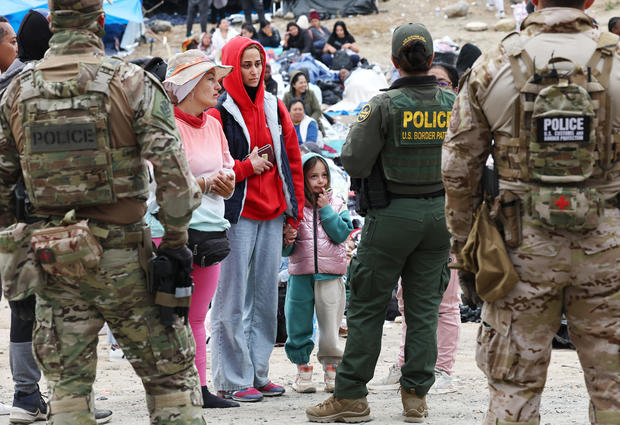An expected spike in illegal crossings at the U.S.-Mexico border following the end of the Title 42 pandemic-era immigration control policy earlier this week did not materialize immediately after the policy change, according to government data obtained by CBS News.
Friday is the first day since March 2020 that the United States can no longer cite Title 42 Border Patrol agents arrested about 6,300 migrants in the drive to deport them, a sharp drop from record levels of illegal entry reported days earlier, a senior U.S. official told CBS News, requesting anonymity to provide undisclosed figures.
Earlier in the week, leading up to the expiration of Title 42 at 11:59 pm EDT on Thursday, the Border Patrol fears Soared to an all-time high. On three days this week, the Border Patrol recorded more than 10,000 migrant apprehensions daily.
In an interview with CBS News, Gloria Chavez, the top border patrol officer in Texas’ Rio Grande Valley, said Saturday was a “quiet day.” He noted that his sector recorded 1,900 migrant apprehensions on Friday, after an average of 2,700 migrant arrivals recently.
Still, Chavez noted that holding facilities in the Rio Grande Valley held about 5,000 migrants as of Saturday, above the 4,600-person capacity.
“We’re not out of the woods yet,” Chavez said. “We’re going to continue to work really hard and get these agents the resources they need.”
Getty Images
A public health authority first invoked by the Trump administration at the start of the Covid-19 pandemic, Title 42 has allowed US border officials to deport 2.7 million migrants to their home countries or to Mexico without hearing asylum claims. Its termination was triggered by the expiration of the Covid-19 public health emergency.
The unexpectedly low number of illegal crossings just after the end of Title 42 may be a sign that the recent spike in migration has peaked before the end of the policy. However, 6,300 daily apprehensions are still a historically high level, and another sharp increase in migrant crossings is likely in the future.
In a federal court filing Friday, Border Patrol Deputy Chief Matthew Hudak said his agency is still preparing for an increase in daily immigrant arrivals of between 12,000 and 14,000. The agency faces major operational challenges with more than 20,000 immigrants in custody and some facilities over capacity.
Concerns about more migrants and overcrowding in Border Patrol custody intensified after a federal judge in Florida earlier in the week. A policy is blocked That allowed the agency to quickly release some low-risk immigrants to reduce the number of people in overcrowded facilities.
The Biden administration urged U.S. District Judge Kent Wetherell to suspend his ruling, saying it would lead to “dangerous overcrowding” and could force the Border Patrol to refuse to arrest some immigrants to mitigate those conditions. But in an order Saturday, Wetherell declined to suspend his ruling, calling the government’s request “out of bounds.”
The “chaos” that the President recently admitted ‘has been going on at the southwest border for several years’ is largely a problem of the defendants’ own making as they have effectively encouraged ‘irregular immigration’ that has been ongoing since early 2021. By adopting and implementing immigration policies that “Prefers ‘alternative to incarceration’ over actual detention,” Wetherell wrote in his order.
The Biden administration is betting that it will be able to reduce the historically high levels of immigration recorded in the past two years with a strategy that combines preventive measures, including more deportations and restrictions on asylum, with expanded legal immigration channels.
A focal point of strategy A rule to be enforced on Fridays It disqualifies immigrants who enter the United States without permission unless they first seek asylum in a third country en route to American soil. Those subject to the regulations could face deportation to Mexico or their home countries, as well as a five-year ban on re-entry to the United States.
At the same time, the administration is expanding programs for immigrants to come to the United States legally, through Mobile app For asylum seekers in Mexico and a program For immigrants from Cuba, Haiti, Nicaragua, and Venezuela who have an American sponsor.
That strategy, however, is now facing legal challenges on multiple fronts. Republican-led states asking A federal judge in Texas blocked sponsorship programs for Cubans, Haitians, Nicaraguans and Venezuelans, while immigrant advocates recently asked a federal judge in California to invalidate the new asylum ban.
During a briefing with reporters on Friday, Blas Nunez-Neto, the Department of Homeland Security’s top official for immigration and border policy, said the administration is “concerned about the impact of litigation on our ability to execute this plan.”
“The cases we’re facing, frankly from both sides of the aisle, clearly show how fundamentally broken our immigration system is,” Nunez-Neto said, adding that the only “permanent solution” to addressing immigration at the U.S. southern border may come. From Congress.
— Nicole Saganga contributed to this report.
More Camilo Montoya-Galvez


